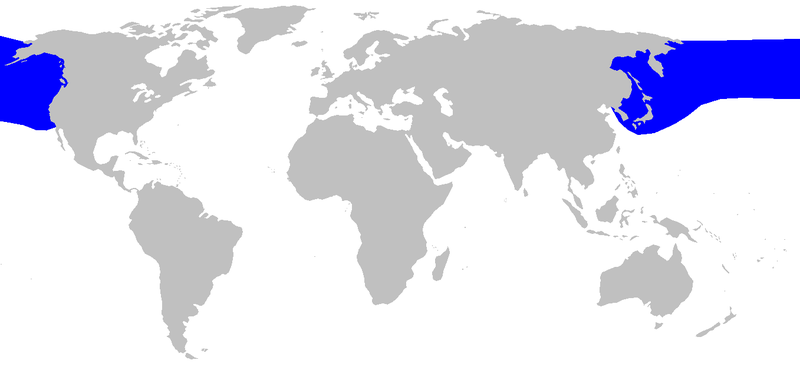Post by Ceratodromeus on Apr 22, 2015 2:26:31 GMT 5

Scientific classification
Kingdom: Animalia
Phylum: Chordata
Class: Chondrichthyes
Subclass: Elasmobranchii
Superorder: Selachimorpha
Order: Lamniformes
Family: Lamnidae
Genus: Lamna
Species: L. ditropis
Description - Lamna ditropis is a midsized species of mackrel shark that inhabits the northern pacific ocean. Regarding body size, The average per caudal length for female salmon sharks 175cm, with a range of 146-200cm. That's based on a sample of 60 individuals. Out of a selected 18 females, the average weigh was 146kg. The males two males recorded in this study measured 175 and 190cm falling within range for the females though no weight is given.[1,2] Growth & maturity of salmon sharks(Lamna ditropis) in the western and eastern North pacific, with comments on back-calculating methods (Goldman &Musick), gave similar results, with the following regarding average and maximum body size for the species
" Adult salmon sharks typically range in size from 180-210cm pre caudal length (PCL;=200-260cm total length) and can weigh up to 220kg(Tanaka, 1980; JAMARC,1980; Nagasawa, 1998) Reported length of 300cm total length and greater & weights exceeding 450kg are unsubstantiated."[2]
The Florida Museum of National History gives the 450+kg figure, but i've yet to find any pictures or documents supporting such a high body weight.
There is not a high degree of sexual dimorphism present within this species, though males tend to mature at an earlier age.
Like other shark species, they're Homeothermic -- meaning they're able to maintain a stable internal body temperature regardless of external influence.
Distribution - These sharks are known to inhabit the regions of the northern pacific ocean, but are highly migratory often traveling great distances.

They are noted as being very abundant in the waters off of Alaska, their movements documented in a 2006 study. you can see the below:

There, they are known to prey on the abundant pacific salmon.
Dietary habits - Salmon sharks are highly oppurtunistic, feeding on anything they can fit into their mouths. for some of the animals noted to have been preyed upon by the salmon shark, here's a detailed list pertaining to species consumed by the shark.
"They prey on a variety of epipelagic fishes and squids (Sano 1960, 1962), although they have been reported to feed on benthic crustaceans, such as tanner crabs
(Chionoecetes sp.) and shrimps, in the Bering Sea (Okada and Kobayashi 1968). There are marked variations in stomach contents between areas and seasons (Sano 1960, 1962; Kawasaki et aI. 1962; Tanaka 1980, 1986; Blagoderov 1993). In subarctic waters, salmon sharks feed mainly on Pacific salmon (Oncorhynchus spp.) in spring and summer, whereas in southern waters they prey on other fishes and squids. Non-salmonids recorded from the stomachs of salmon sharks sampled in subarctic waters include squids, daggertooth (Anotopterus pharao), longnose lancetfish (Alepisaurus jerox), Atka mackerel (Pleurogrammus monopterygius), Pacific spiny lumpsuckers (Eumicrotremus orbis)* , walleye pollock (Theragra chalcogramma), Pacific sauries (Cololabis saira) , spiny dogfish (Squalus acanthias), lanternfishes (Myctophidae), Pacific pomfret (Brama japonica), and chub mackerel (Scomber japonicus). Of these animals, squids are most frequently eaten. The first five teleosts are eaten in northern subarctic waters but the remaining teleosts are preyed on in southern subarctic waters.
The salmonid species eaten by salmon sharks are sockeye salmon (0. nerkil), chum salmon (0. keta), pink salmon (0. gorbuscha), coho salmon (0. ldsutch), and chinook salmon (0. tshawytscha) (Sano 1960, 1962). There was no record of steelhead trout (0. myldss). Of 859 and 176 salmon sharks caught in the western
North Pacific and Bering Sea from late May to early Augustin 1959 and 1960, 68 and 39% (mean 63% for both years combined) were found to have salmonids in
their stomachs (Sano 1960, 1962; Fig. 6A). Other fishes and squids were found in 2 and 27 % (mean 7 %)
of the stomachs. Empty stomachs were often observed in both years (30 and 34% [mean 31 %]). There was a trend towards a higher frequency of occurrence of
salmonids in salmon shark stomachs in waters of high salmonid abundance. Sockeye salmon were most frequently eaten, followed by chum or pink, coho, and chinook salmon (Sano 1960, 1962). Sockeye salmon accounted for 42 and 40% of the records in 1959 and 1960 (Fig. 6B). A single salmonid was found most often (80.1 %).The largest number of salmonids found in a single stomach was three. "[3]
Reproduction - Male and female salmon sharks mature,
respectively, at 140 cm PCL and between 170 and 180
cm Pre caudal length(PCL) though as stated earlier, males mature at an earlier age (at roughly 5 years of age vs 8-10 years in females). Mating occurs in Autumn, with any where from 2-4 young being birthed in may or april. At birth young are between 60 and 65 cm PCL, and are fully independant.
References:
[1] Hulbert, Leland B.; Rice, J. Stanley (December 2002). "Salmon Shark, Lamna ditropis, Movements, Diet and Abundance in the Eastern North Pacific Ocean and Prince William Sound, Alaska". Exxon Valdez Oil Spill Restoration Project 02396.
[2] Goldman, Kenneth; Musick, John A. (2006). "Growth and maturity of salmon sharks (Lamna ditropis) in the eastern and western North Pacific, and comments on back-calculation methods". Fishery Bulletin 104 (2): 278–292.
[3] Nagasawa, Kazuya (1998). "Predation by Salmon Sharks (Lamna distropis) on Pacific Salmon (Oncorhynchus spp.) in the North Pacific Ocean". Bulletin of the North Pacific Anadromous Fish Commission 1: 419–432.


